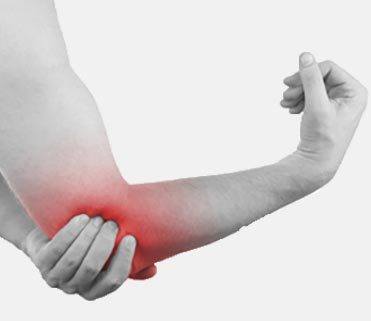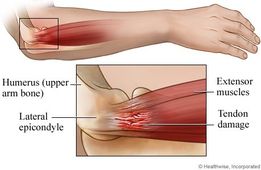Tennis Elbow

Tennis elbow, otherwise known as lateral epicondylitis, is where small tears in the tendons of the forearm muscles result in inflammation, due to overuse & incorrect wrist action, causing pain on the outer elbow. It affects approximately 50% of tennis players due to the repetitive movements.
CAUSES:-
• repetitive movements of the arm subjecting it to repeated force
• Incorrect technique causing more stress on the wrist instead of the impact being taken through the elbow and shoulder. This increased pressure on the tendon causes inflammation.
• Overuse through daily activities such as using scissors, gardening & manual work eg. plumbing, typing
• sports that involve repetitive throwing

SYMPTOMS:-
• recurring pain on the outer upper forearm, just below the bend of the elbow, which may radiate towards the wrist
• Pain on lifting, bending the arm, writing or gripping small objects.
• pain when twisting the forearm eg turning a door handle
DIAGNOSIS:-
Diagnosis should be made by a medical professional but the following test will give an indication of tennis elbow if there is pain. Stand behind a chair and place your hands on top of the chair back, with downward-facing palms & straight elbows. Try to lift the chair.
TREATMENT:-
• Rest - allows the tears in the tendon to heal
• Ice packs
• Massage
• Physical therapy – to strengthen their shoulder, upper arm, & abdominal muscles which reduces impact on the wrist during arm movements.
• Strapping the forearm to help realign the muscle fibres & relieve pressure
• Steroid injection if pain is particularly bad
• Botox injections
• extra-corporeal shock wave therapy (ESWT)
• heat therapy
• trigger point therapy
• Surgery (rare)
• Wearing a splint to prevent further damage
The Tyler Twist exercise can be used to strengthen the muscles in cases of tennis elbow and the reverse Tyler twist for Golfer’s elbow. Grip a long, thin object , such as a Flexbar, with both hands & hold it vertically in front of your chest. Grip with both hands facing the same way with both wrists in full extension or bent back. Move the injured wrist into flexion so it bends forward around the object, and keeping in flexion rotate the object into a horizontal position, like handlebars of a bicycle. Hold your arms straight out in front of your body then move the uninjured wrist into flexion, joining the affected wrist.

PREVENTION:-
• Stretching
• Learning correct techniques to avoid excessive stress on the elbow & allow the shoulder and upper arm to absorb some of the impact
• Warming up – stretching will help avoid injury in sports with repetitive movements
• Use lightweight equipment with a larger grip size will help reduce strain on the tendons.
• strengthen forearm muscles to support arm movement
